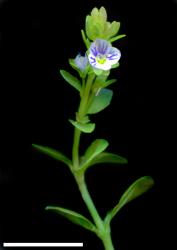- Taxon
- Gallery
Perennial herb to 0.25 m tall. Stems decumbent and rooting at nodes below, ascending to erect above, eglandular-hairy; hairs uniform, antrorse. Leaf bud indistinct; leaves separating while very small, opposite-decussate, erecto-patent to spreading; lamina thin, broadly ovate to broadly elliptic, to orbicular, 5–17 mm long, 4–15 mm wide, dull green above, paler beneath; midrib and 2–4 lateral veins evident; surfaces glabrous or sparsely minutely eglandular-puberulent; margin glabrous or sparsely ciliolate, shallowly crenate or crenate-serrate, rarely entire with marginal hydathodes, teeth in 3–8 pairs; apex and base more or less rounded; petiole 0.5–5.0 mm long. Inflorescence a terminal raceme, 20–60 (rarely to 110) mm long; flowers crowded at first, becoming distant, 3–12 (rarely to 60), all bisexual; bracts alternate or rarely the lowermost opposite, oblanceolate to elliptic, overtopping pedicels, the lowest leaf-like, becoming smaller above; pedicels erecto-patent, 1–3 mm long, shortly eglandular-puberulent all around. Calyx lobes 4, obtuse, more or less equal, 2–3 mm long, glabrous or sparsely eglandular-puberulent especially at base. Corolla 3–5 mm diameter, tube white and yellow, <1 mm long, < calyx, hairy at throat; lobes 4, pale blue fading to whitish, or rarely white or blue, darker inside and on posterior lobe, sub-erect to erecto-patent, unequal, broadly ovate to orbicular, 2–3 mm long (check), obtuse to rounded, nectar guides dark blue or purple, on posterior and lateral lobes. Stamen filaments white, 1.5–2.0 mm long; anthers blue. Style blue, 1.7–2.0 mm long. Capsules angustiseptate, emarginate to obcordate, sparsely glandular ciliate on margins, 3.0–3.5 mm long, 3.5–4.0 mm wide at widest point. Seeds, ellipsoid, flattened, smooth, pale brown, 0.5–0.7 mm long.
V. serpyllifolia plants are distinctive among New Zealand species of Veronica. Characteristic features for their identification include the perennial habit with basal part of the stem decumbent and rooting at the nodes, short, antrorse stem hairs, almost glabrous dull green leaves, small, usually very pale blue corolla with a short anterior lobe, and rounded, emarginate capsule with marginal glandular cilia.
V. peregrina plants have a similar growth form, but differ in being annuals, completely glabrous, their flowers are almost sessile (pedicels <0.5 mm long), the corolla is pure white without nectar guides, the styles <0.2 mm long, and the capsules are a little smaller and more rounded.
North Island: throughout.
South Island: throughout.
Stewart I., Chatham Is., Campbell I.
Wetlands in open turf and grassy places, pasture and lawns (usually damp), flushes and bogs. Recorded elevations range from 0 to 1281 m.
| Category | Number |
|---|---|
| Exotic: Fully Naturalised | 1 |
| Total | 1 |
Kirk in Hooker (1864, p. 217). Voucher likely to be WELT SP63061, 63064, T. Kirk, Auckland.
Flowers: January–December; fruits: January–December.
2n = 14, 28, from overseas material (Albach et al. 2008).
Veronica serpyllifolia is classified in V. subg. Beccabunga (Albach et al. 2004; Albach & Meudt 2010), along with V. americana, V. anagallis-aquatica, V. catenata and V. peregrina.




